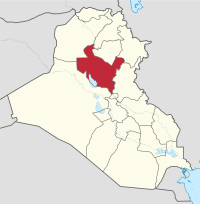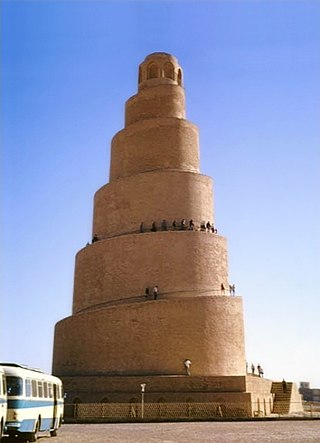Saladin Governorate
Governorate of Iraq From Wikipedia, the free encyclopedia
Governorate of Iraq From Wikipedia, the free encyclopedia
The Saladin, Salah ad Din, or Salah Al-Din Governorate (Arabic: محافظة صلاح الدين, Muḥāfaẓat Ṣalāḥ al-Dīn) is one of Iraq's 19 governorates, north of Baghdad. It has an area of 24,363 square kilometres (9,407 sq mi), with an estimated population of 1,042,200 people in 2003. It is made up of 8 districts, with the capital being Tikrit. Before 1976 the governorate was part of Baghdad Governorate.
Saladin Governorate
صلاح الدين | |
|---|---|
| Ṣalāḥ al-Dīn | |
 | |
| Coordinates: 34°27′N 43°35′E | |
| Country | Iraq |
| Capital | Tikrit |
| Governor | Badir al-Fahl |
| Area | |
• Total | 24,751 km2 (9,556 sq mi) |
| Population (2018) | |
• Total | 1,595,235 |
| Official language(s) | Arabic |
| HDI (2021) | 0.692[1] medium |
The governorate is named after the Kurdish Muslim leader Saladin or Salah ad Din, who hailed from the governorate. This Sunni-dominated governorate is also known as the home of Saddam Hussein, who hailed from the village of Al-Awja. Salah Al-Din governorate, a traditional stronghold of Saddam and his Al-Bu Nasir tribe that is located in the heart of the Sunni Triangle, has been rocked by insurgencies, tribal rivalries, political and sectarian violence ever since U.S.-led Coalition forces invaded Iraq in 2003.[2]

Saladin Governorate contains a number of important religious and cultural sites. Samarra, the governorate's largest city, is home to both the Al-Askari Shrine (an important religious site in Shia Islam where the 10th and 11th Shia Imams are buried), and the Great Mosque of Samarra with its distinctive Malwiya minaret. It also contains an old Zengid mosque.
Samarra was the capital of the Abbasid Caliphate in the 9th century CE, and today Abbasid Samarra is a UNESCO World Heritage Site.
The ancient Neo-Assyrian Empire Assyrian city of Assur is located in Al-Shirqat District on the banks of the Tigris River. Other sites in the governorate include the Crusader Dome (القبة الصلبية) north of Samarra and the Al-`Ashaq Palace (قصر العاشق). Today, the Saladin Governorate has a diverse population of Arabs, Kurds, Turkmens and Assyrians.
In January 2014, there were plans announced by Prime Minister Nouri al-Maliki to make the Tuz Khurmatu district into a new governorate due to its Turkmen majority.[3] However, these plans were not implemented.[4]
In October 2011, the governorate's administration declared itself a semi-autonomous region, explaining that the declaration was in response to the central government's "domination over the provincial council authorities".[5] Saladin, which is a largely Sunni governorate, is also hoping that by declaring themselves an autonomous region within Iraq, it will entail them to a larger portion of government funding.[5] The council cited "article 119 of Iraq's constitution" in its call for autonomy, which states that "one or more governorates shall have the right to organize into a region" if one third of the Provincial Council members or one tenth of the voters request to form a region".[6]

The following table shows the populations of the districts of Saladin Governorate, according to the United Nations in 2003. No data is available for Dujail District.
| District | Samarra | Tikrit | Balad | Baiji | Al-Shirqat | Al-Daur | Tooz | Total |
|---|---|---|---|---|---|---|---|---|
| Population | 348,700 | 180,300 | 107,600 | 134,000 | 121,500 | 46,700 | 103,400 | 1,042,200 |
Seamless Wikipedia browsing. On steroids.
Every time you click a link to Wikipedia, Wiktionary or Wikiquote in your browser's search results, it will show the modern Wikiwand interface.
Wikiwand extension is a five stars, simple, with minimum permission required to keep your browsing private, safe and transparent.